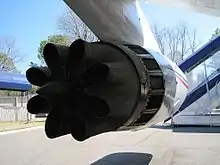Exhaust mixer
In aviation, exhaust mixer is a feature of many turbofan engines, where the bypass (cold/slow) air is mixed with the core (hot/fast) exhaust gases, before exhausting to atmospheric pressure through a common (mixed flow) propelling nozzle.

Benefits

The mixer reduces the velocity of the core exiting air, and consequently, reducing the amount of noise produced. Additionally, the temperature of the exhaust is reduced, contributing to the overall reduction of the thermal signature of the aircraft. This attribute is critical in military aircraft where thermal detection or heat-seeking weapons are used.
Ideally, a mixer is also a performance benefit to increasing thrust. The exhaust thrust from a jet engine is equal to exhaust mass flow times exhaust velocity, i.e., Thrust = ṁv, while the energy to make that thrust is given by Energy = 1/2mv2. A mixer helps reduce the fastest exhaust velocities from the core of the engine, while making the average exhaust velocity faster, producing more thrust with the same energy.
_(cropped).jpg.webp) The Trent 700 which powers the Airbus A330, has a common nozzle assembly which mixes the cold and hot flows.[1]
The Trent 700 which powers the Airbus A330, has a common nozzle assembly which mixes the cold and hot flows.[1]_(4337113707).jpg.webp) The PW4000 has separate exhaust nozzles
The PW4000 has separate exhaust nozzles
Mixer types
_Radom_-_panoramio.jpg.webp)
- Annular - bypass and core streams are brought together co-annularly, mixing being achieved by the shearing effect at the stream interface
- Forced - hot and cold chutes, intertwined, force the two streams to mix
Mixing efficiency is defined in a number of ways, but simply, compares the actual thrust gain (due to mixing) to that of the ideal case. Annular mixers have a low pressure loss, but a low mixing efficiency. Forced mixers can have a high mixing efficiency, but this is offset by a high pressure loss.
Mixers are extremely common on military turbofans, since long coaxial exhaust pipes (i.e. hot and cold) are avoided. Afterburning, with the associated variable area nozzle, is also easier to accommodate.
Some high bypass ratio (e.g. civil) turbofans now feature a mixer, the advantage being a small thrust gain, which improves specific fuel consumption. Although the mixing process is not thorough, there is a jet noise benefit as well.
See also
References
- Lufthans Technical Training,Training Manual Airbus A330,ATA71-80 Engine RR Trent 700,page 30